
Assemble a Competent Web Development Team: Roles, Skills, and Qualities
Putting together a good web development team is a process of trial and error, but it’s worth the effort to build a web application that lifts your business to a higher level. Discover everything you need to know about such a team right in this article.

Content Map
More chaptersIt takes a village to develop a good web application that achieves your business objectives. However abundant your resources, the people directly involved in the development process can make or break the final software. Knowing their roles, skills, and qualities is essential to setting realistic expectations and building a good relationship with the team.
A good relationship comes in handy in case of problems or confusion: you’ll know who to contact, whose work is affected, and how adjustments can be managed. Rather than answering how much web developers earn, this article outlines the typical roles of a web development team and their importance.
Key Takeaways:
- A typical web development team often consists of several essential roles that work together for the web application’s success, including frontend developers, backend developers, UI/UX designers, and a project manager.
- Partnering with a software development company is one of the ideal ways to quickly access a dedicated web development team or specific specialized roles without the difficulty of hiring.
- The cost of a web development team ranges from as low as $7K – $18K per month in Asian countries and as high as $30K – $60K+ per month in the US/Western Europe and is affected by various factors such as team size, project complexity, and engagement duration.
What Is a Web Development Team?
A web development team refers to a group of individuals who collaborate closely to turn design concepts and business requirements into fully functional web apps. They are responsible not only for building websites or web applications but also for the entire process of planning, designing, testing, and maintaining the product. The size and specific roles within a web team are never fixed and depend largely on the needs and budget constraints of each project.
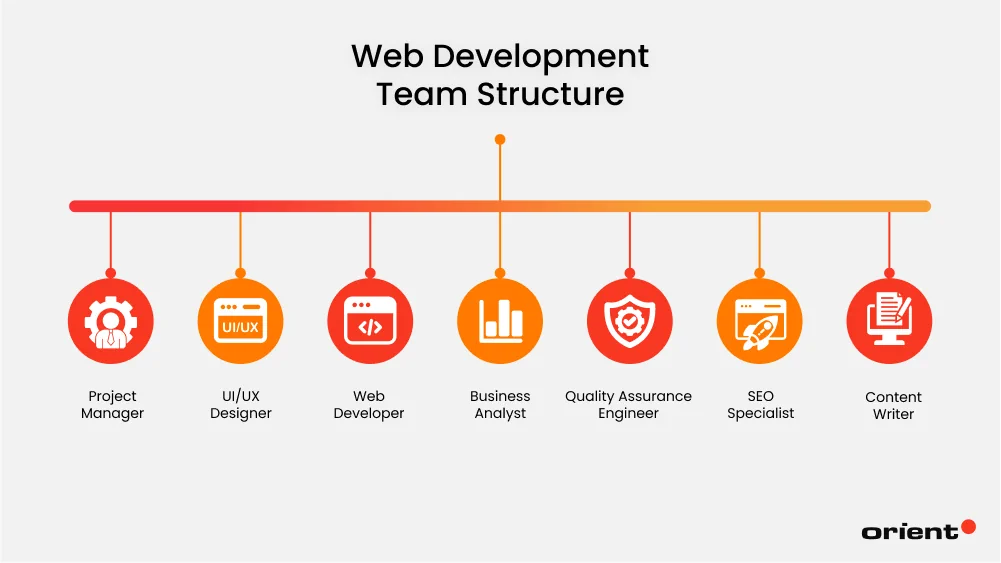
A Group-Based Web Development Team Structure for Business Success
Instead of listing web development team roles in the usual way, which may lead to confusion due to their potential overlaps, dividing and grouping roles into specialized groups within the team based on the collective expertise and diverse skill sets is more effective regarding communication and productivity.
Below is a group-based web development team structure for business success.
#1 Leader: Project Manager & Solution Architect
A web development project has two sides - the business side and the IT side. A project’s leading roles also require a combination of business acumen and technological know-how. Project managers and solution architects act as a bridge between the technical staff and the business-people like you. While the project manager leans toward the business side, the solution architect contributes technical specifications.
One may argue that a web development project only needs one leader; the preference for a manager or an architect lies in the kind of organization. If you value technical leadership, then you may opt for a solution architect. On the other hand, if your company emphasizes management, opting for a project manager is a wise choice.
The two roles have differences that complement each other. Senior Architect Rajat Bhatla suggests that a symbiotic relationship between the two - a joint leadership - would best benefit a large, complex project.
Both are valued for their ability to negotiate project requirements between business and technological interests. The leader who can shield their team from changing requirements or involve their developers in estimations often garners the most satisfaction from team members.
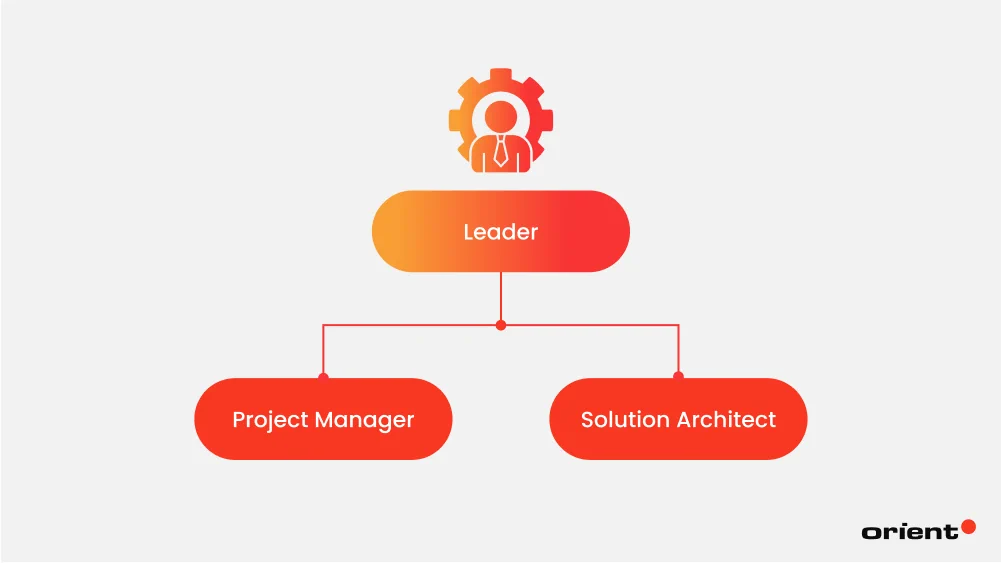
Project Manager
The project manager plays the most important role in the web development team and is the magnetic needle in overseeing and managing the entire project lifecycle, from initiation to delivery. By keeping the big picture in mind, they are responsible for coordinating the project according to the initially set direction.
Specifically, the project manager is the individual who works directly with clients and stakeholders to gather requirements, thereby creating a detailed plan including a realistic timeline, communication strategies, risk assessment, and required efforts. They ensure all the team members work closely towards the common goal of delivering a successful web development project.
As the quality of the web app is the project manager’s final goal, resource allocation is always done with great effort to optimize productivity while minimizing waste.
Core competencies: mastery of project management methodologies (Waterfall, Scrum, or Kanban), project planning, leadership, quality management, and people management.
Solution Architect
Also known as a project architect, the role of a solution architect is relatively new and evolving. The need for such a role comes from the evolving digital transformation and the increasing demands for multiple, interconnected technological solutions for contemporary businesses. As web development projects get more complex and IT roles get more specialized, senior tech workers are called upon to provide a blend of business and technical leadership as solution architects.
Their responsibilities revolve around researching and designing a system of solutions to satisfy complex business requirements. As former senior software engineers, solution architects are much better equipped than project managers to make technological decisions. Their leadership includes choosing the right tools, assembling the right people, identifying risks and challenges, and organizing the workflow.
On the business side, they translate technical terms and concepts for non-technical stakeholders, driving the alignment between business goals and technology solutions. A good solution architect can juggle business requirements, stakeholders’ expectations, and technological capabilities.
Core competencies: technical expertise, system integration and design, business acumen, people management, and project management.
#2 Designer: UI Designer & UX Designer
The UI/UX designer is also a relatively new role, necessitated by the need to keep users satisfied and loyal. Without proper UI/UX design, your web app may end up with an interface that is confusing and unappealing to users, leading to high bounce rates and low engagement.
This role combines two complementary skill sets of the web designer: user interface (UI) design and user experience (UX) research. In fact, it is common for companies to hire individuals who have both skills to save budget and boost collaboration efficiency. However, there are certain projects and organizations where it may be more practical to have separate UI and UX design roles.

UI Designer
UI design is akin to graphic design for web pages, explicitly relevant to the application interface. It’s about designing the look and feel of the website using audiovisual elements such as color schemes, icons, buttons, images, logos, backgrounds, typographies, animation, etc.
The task of UI designers revolves around ensuring the web interface is user-friendly, intuitive, aesthetically pleasing, and aligned with the brand identity. Graphic design tools like Adobe Photoshop, Sketch, or Figma are indispensable components that help them create high-fidelity mockups and prototypes.
Because the ultimate goal of visual designs is customer satisfaction with a certain web app, UI designers must constantly cultivate creativity, stay updated on emerging design trends, and understand user psychology and behavior to meet increasing aesthetic demands.
Core competencies: visual design, interaction design, responsive design, branding and typography, and graphic design tools.
UX Designer
UX has bigger goals than UI. UX research is the foundation of knowledge that informs UI/UX design principles. It involves extensive study and research into the user’s journey of using the web app, from the landing pages to specific functions. A good UX designer understands the users’ behaviors, psychology, and expectations as thoroughly as walking in their shoes. They prioritize optimizing users’ interactions with the product.
Their deliverables are mockups, wireframes, and prototypes, informed and tested by thorough user research. In a web development team, they collaborate with the developers to design technologically feasible and aesthetically pleasing user experiences.
Core competencies: wireframing and prototyping, user research, information architecture, and interaction design.
#3 Web Developer: Front-end Developer & Back-end Developer
As the core of a development team, developers create the software features by writing code in programming languages, using libraries, and designing frameworks. Writing code from scratch is the primary activity; just like writing a book, coding takes the most time and effort from the developers.
Due to a shortage of developers in recent years, businesses have turned to hiring offshore developers from outsourcing services or freelance web developer for the sake of saving hiring time and achieving desired outcomes.
Whatever the recruitment method is, a web developer typically specializes in front-end (client-side) or back-end development (server-side). The client side has the features users see and interact with. The server side has the database, modeling, and architecture that enable smooth functioning with the potential to scale with user growth.
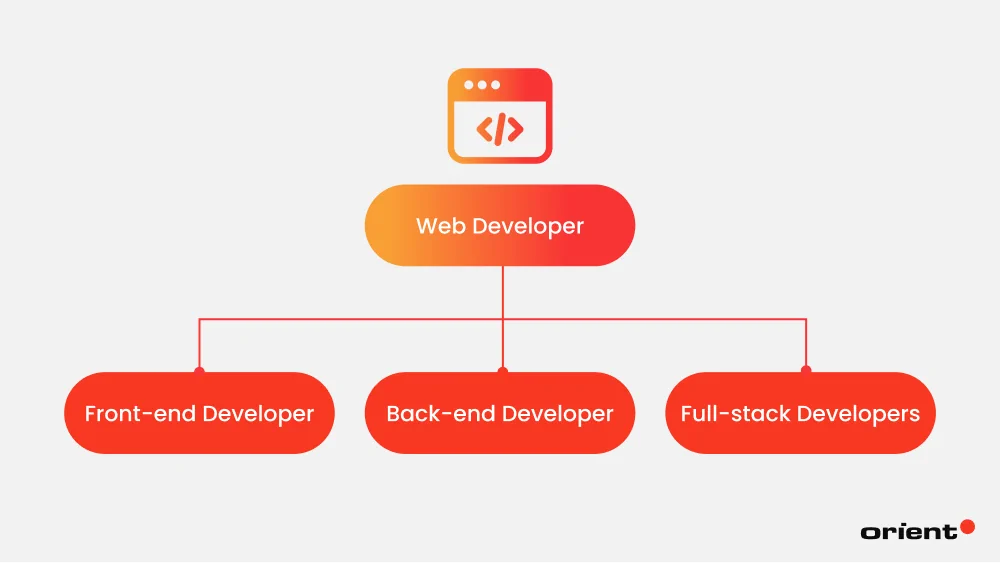
Front-end Developer
Front-end developers build the client side of the web app. They write code to implement customer-facing features, ensuring the user interface is responsive and seamless. By using a combination of HTML, CSS, and JavaScript, front-end developers are responsible for translating designs and mockups from UI/UX designers into actual functioning web pages.
Besides being proficient in these core technologies, they must also be equipped with other web development skills, including understanding various frameworks, libraries, and tools to serve the development process more comprehensively. Like UI/UX designers, an excellent front-end developer prioritizes the users’ needs. They may benefit from having some design skills to work closely with UI/UX designers, ultimately creating engaging, responsive, and user-friendly digital experiences.
Core competencies: front-end programming languages, responsive design, web development frameworks and libraries, cross-browser compatibility, and performance optimization.
Back-end Developer
While front-end developers concentrate on client-side interactions, back-end developers work behind the scenes to handle business logic, data storage, and processing. Whether the functions and performance of web apps operate smoothly or not depends on the backend web developer skills.
Their specific responsibilities include working with a database to ensure proper data management and integrity, handling security aspects to protect sensitive data, and optimizing web performance to improve response times and scalability. Dealing with more logic-based problems, back-end developers must have solid basic knowledge of server-side programming languages, types of databases, tools, and frameworks to create robust and scalable web applications that power the user experience on the front end.
Core competencies: back-end programming languages, database management, web frameworks, API development, performance optimization, and security.
Full-stack Developers
In some web development teams, full-stack developers are included in place of separate frontend and backend roles, as they are capable of handling both server-side development and client-side development.
This alternative is often suitable for web app projects from startups where cost savings and faster development cycles are crucial. Instead of hiring two separate specialists, you can simply hire one skilled full stack web developer and let him/her handle both frontend and backend tasks. Working independently also reduces communication bottlenecks and provides a unified view of the system.
Although dedicated full-stack developers can be helpful for coordinating both sides, but they should not be forced to work solo on the entire app. This position is not suitable for large and complex projects or projects that require deep expertise in either frontend (UX/UI-heavy apps) or backend (complex data, security, integrations).
Core competencies: backend development, frontend development, database management, security best practices, software architecture, and integration.
#4 Other Roles
With the above roles, you have basically built a successful web team. However, based on the nature and scale of the project, there is no general formula for such structures.
Businesses may have other roles in their web development teams besides the core roles. Regardless of the added position, each role with specialized expertise contributes to different aspects of the development process, ultimately leading to the successful delivery of a high-quality web application that meets user needs and achieves business objectives.
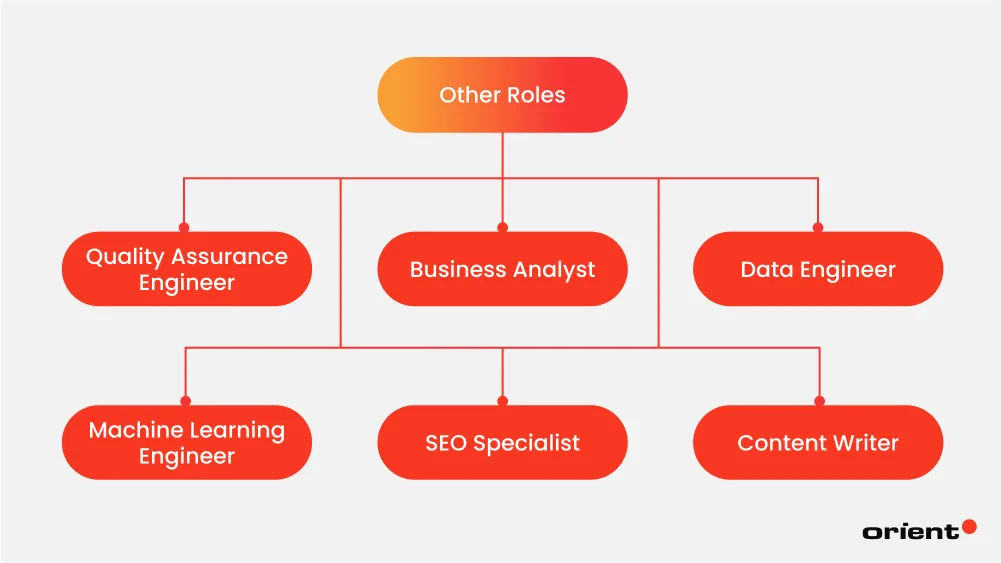
Quality Assurance Engineer
No long-lasting quality web app exists, as cybersecurity risks and unwanted technical issues may arise at any time during the software’s operation. That’s why businesses, regardless of size, always consider the significance of dedicated QA roles within a web development team.
A quality assurance engineer is an expert in ensuring the overall quality of the software development process. QA encompasses a broader role that goes beyond testing activities. On the contrary, they closely monitor most of the various stages of the software development lifecycle, from requirement gathering, design, and coding to testing and deployment to control the operating status of the web apps always smoothly and without bugs.
Quality assurance engineer also ensures other team members comply with project standards, company policies, and external standards (such as ISO). They ask “what if” questions to test the software’s performance in the most likely non-ideal situations.
A successful web development project integrates quality assurance from the beginning. QA engineers generate test cases, run the tests, and compile test reports. Then, they have to be tactful in delivering those reports to web developers. While web developers may overlook minor bugs to meet their deadlines, QA engineers provide objective feedback on the quality of the tasks and keep everyone focused on project requirements.
Core competencies: testing methodologies, defect tracking, test planning, manual testing practices, and test automation tools.
Business Analyst
Business analysis plays a crucial role in bridging the gap between technical solutions and business objectives within an organization. At its core, they are experts who collect data related to software products, often opinions and feedback from stakeholders from various departments, and translate them into actionable requirements.
By using techniques such as interviews, workshops, and document analysis, business analysts understand better than anyone the desires of business users, managers, and IT teams, thereby turning them into deep insights about the current state of the business and identifying areas for improvement.
The concise document, which represents requirements from stakeholders, then serves as a blueprint for developers, testers, and other team members to understand what needs to be accomplished.
Core competencies: requirement analysis, business process modeling, data analysis, and domain knowledge.
Data Engineer
Data engineers are necessary for companies struggling to deal with massive data volumes. Data engineers are professionals who design, develop, and manage the infrastructure for collecting, storing, and processing data systems.
Their responsibilities are broad and include all elements related to data. Specifically, data engineers build automated data pipelines to transfer data from various sources to destinations like data warehouses or analytics platforms.
By retrieving aggregated information, they gain valuable insights, strengthening the business’s decision-making process. Data engineers are also responsible for controlling data quality and enforcing data governance practices.
Core competencies: data modeling, data-related programming languages, data integration, database management, data warehousing, and data processing.
Machine Learning Engineer
Adding AI capabilities means empowering your web app with tons of favorable benefits. However, this integration process is more than a daunting task and requires extensive knowledge of machine learning. This is where machine learning engineers come in to help.
A machine learning engineer is an expert in designing and deploying machine learning models and systems for businesses regardless of industry. Applying the intersection of computer science, data science, and software engineering, they build intelligent systems that can learn and make predictions based on data.
To take advantage of collected data and turn it into valuable information, machine learning engineers are responsible for developing and training machine learning models that can analyze large datasets and identify patterns or insights.
Core competencies: data-related programming languages, applied mathematics, machine learning algorithms, data modeling and evaluation, deep learning, and MLOps.
SEO Specialist
Search engine optimization (SEO) specialists may not have an obvious role on a mobile development team, but they’re important for a web development team. The SEO specialist works with web developers to make sure a website is SEO-friendly. This makes the web app more visible on search engines, thus attracting more interested users.
SEO work also includes significant enhancements, such as making the web app mobile-friendly, responsive, and secure. These improvements raise the site’s authority, making it easier for users to find and use your web app.
Core competencies: keyword research, traffic analysis, SEO optimization, competitor analysis, ranking strategy, and link-building.
Content Writer
Together with SEO specialists, content writers are part of the web development team that contributes significantly to the development of websites, especially customer-facing and content-heavy web apps. While SEO executives improve a website’s visibility in search engines like Google to increase organic traffic, content writers structure website content for responsiveness and accessibility.
The primary responsibility of SEO writers in web development is to optimize SEO knowledge to create content (e.g., headlines, blogs, product descriptions, landing pages) that is friendly to readers and their search intent, helping in ranking the business’s website on Google.
In addition to working closely with SEO specialists to implement SEO strategies, content writers also work with UI/UX designers to make sure content fits within layout constraints, ensuring a seamless user experience and appropriate for visitors as a whole.
Core competencies: writing skills, SEO knowledge, content structuring, research skills, and audience awareness.
What Makes a Good Web Development Team?
A good website development team thrives on solid expertise, effective collaboration, and problem-solving ingenuity. They take the time to understand your business challenges, research, and design multiple solutions with the willingness, capabilities, and curiosity to test them out. They pay attention to the specific requirements of your industry, drawing from their experience in developing similar products or having the skills and open minds to learn. They clarify the blind spots and misunderstandings you may have held about development.
To achieve the best cost-efficiency, the team has a blend of junior and senior engineers. They take pride in writing clean code, making the best use of libraries, frameworks, integrated tools, automation, and DevOps. Another software engineering best practice is to keep meticulous documentation to optimize the development process. Most importantly, they have transparent communication and an absolute commitment to delivering the best possible results within the allocated time.
Tips for an Efficient Web Developer Team
As each member of a web development team is an individual, managing people (or team management) is considered a difficult task that requires a lot from the leader. Here are some useful tips to help you build a more effective software development team.
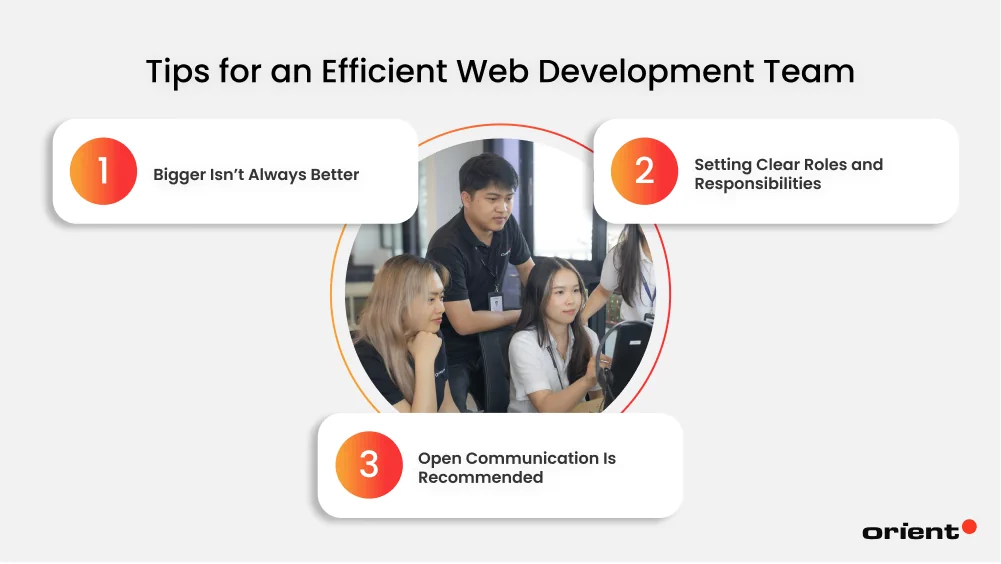
Bigger Isn’t Always Better
Some technology companies are, so far, still following a bigger-is-better approach. In other words, in some teams, especially under intensive deadlines, assume that scaling up in terms of the number of developers will automatically speed things up.
However, not every project benefits from this, as the more people do not mean the sooner the job gets done. Larger teams without the right management methods can result in misunderstandings and lengthy processes. Onboarding more team members also requires more time to ramp up and understand the codebase.
Instead, choosing quality individuals and alignment over quantity is recommended. Hire web programmers as you need in a given timeframe and only scale up when you see signs of a change in scale. The goal is not to have more hands, but smoother execution.
Setting Clear Roles and Responsibilities
While roles refer to employee positions in the company, responsibilities are specific jobs that fall under a person’s role. When recruiting, it’s important to establish the job position, but outlining the candidate’s responsibilities to fulfill that role is equally essential. Clearly defining roles and responsibilities is one of the most impactful steps in developing an efficient web development team.
As everyone knows what they are responsible for and what they are not, you will avoid situations where tasks get duplicated (two people unknowingly working on the same thing) or tasks get missed (everyone assumes someone else is handling it). Micromanagement is also minimized, freeing up valuable time for leaders to focus on core competencies.
Open Communication Is Recommended
In the workplace, effective communication is not only about conveying information clearly and accurately in a way that is understood, but also about openly and honestly sharing constructive personal opinions and questions related to the job.
A web development team made up of highly skilled professionals who only adhere to the direction of their superiors without offering any additional input or contribution is likely to become passive and create web projects that lack diverse perspectives in the long run.
However, creating a trust-based environment where people feel comfortable expressing themselves without fear of judgment or backlash is difficult. Start small by using support tools such as Slack, Jira, or Trello to stay transparent and remove barriers to direct communication. Stand-ups and retrospectives to share progress and blockers should be held periodically, and mutual dialogue should be encouraged among all participants. Above all, everything should be conducted with respect, constructiveness, and a focus on ideas rather than personal attacks.
Build a Successful Web Development Team with Orient Software
Putting together a good team is a process of trial and error, but it’s worth the effort to build a web application that lifts your business to a higher level. By partnering with Orient Software, a web development company team, and outsourcing experts from our dedicated software team service, you save the majority of time and budget, eliminate recruitment burdens, and quickly bring your innovative web app ideas to life. Contact us now!






